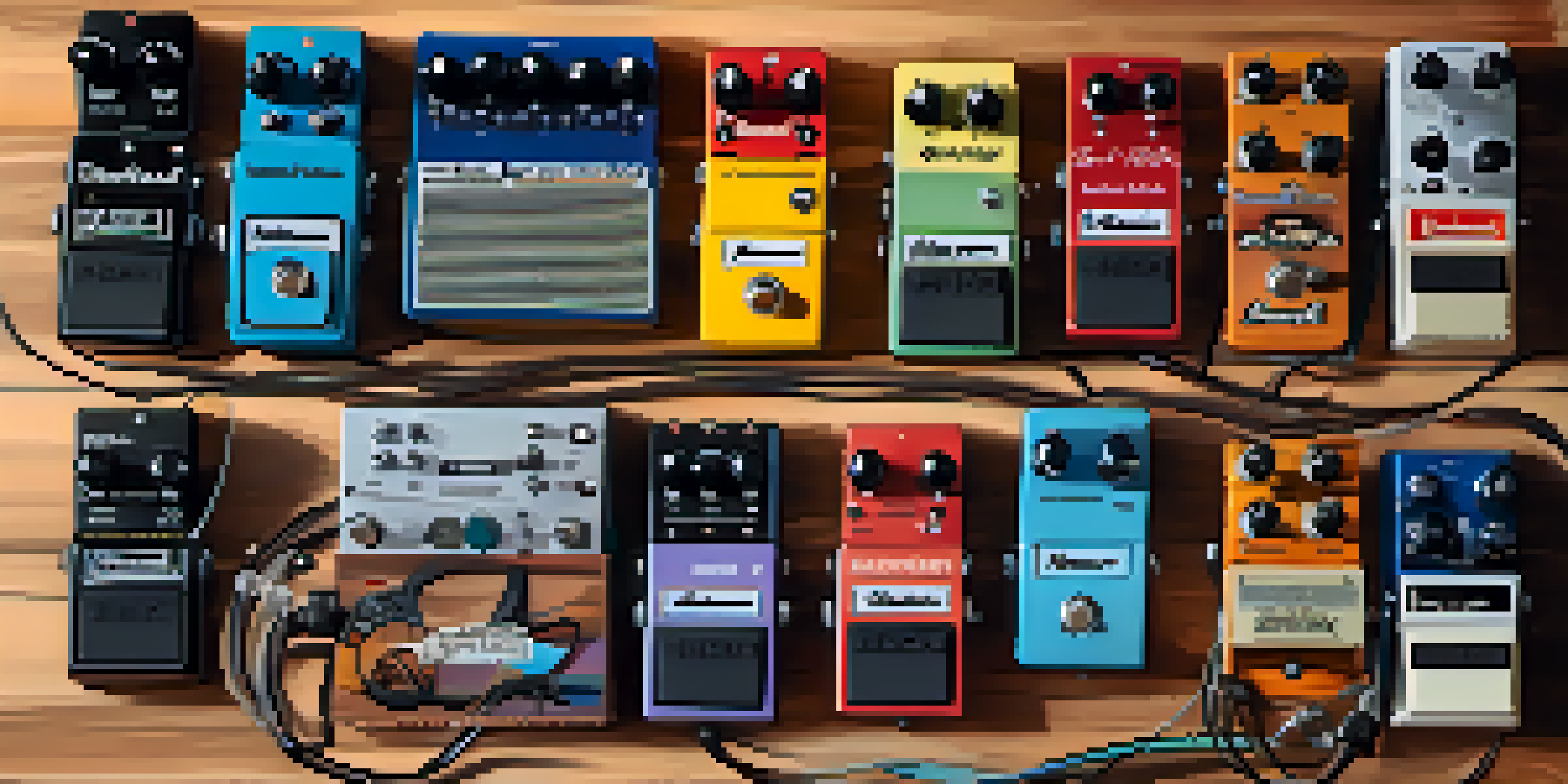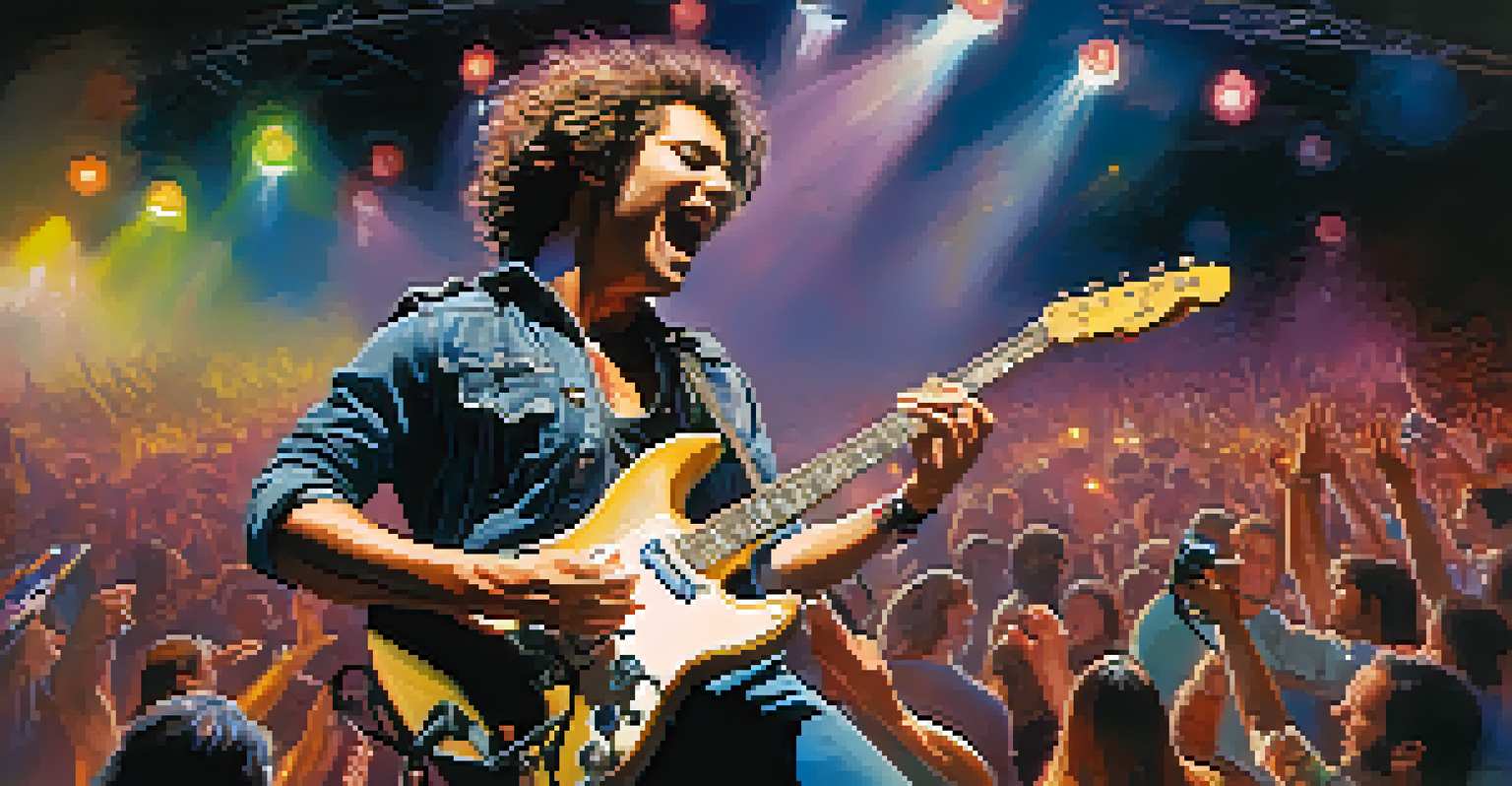The Role of Guitar in Shaping Rock Music's Iconic Sound

The Evolution of the Electric Guitar in Rock
The electric guitar transformed rock music in the mid-20th century, providing a new sound that resonated with audiences. Before its advent, rock was largely driven by acoustic instruments, which limited the genre's dynamism. The introduction of the electric guitar allowed musicians to experiment with volume, tone, and effects, paving the way for a more diverse sound. This shift made the guitar a central figure in the rock genre, influencing countless artists and bands.
The guitar is the easiest instrument to play and the hardest to play well.
As rock music evolved, so did the electric guitar. Iconic models like the Fender Stratocaster and Gibson Les Paul became synonymous with rock legends, offering unique tonal qualities that defined the genre. Guitarists like Jimi Hendrix and Eric Clapton pushed the boundaries of guitar playing, incorporating techniques such as distortion and feedback to create signature sounds. Their innovative approaches not only showcased the guitar's versatility but also inspired future generations of musicians.
Today, the electric guitar remains a staple in rock music. Its ability to convey emotion and energy continues to captivate audiences, making it a vital tool for both seasoned professionals and aspiring musicians. As rock evolves with new influences, the electric guitar adapts, ensuring its place in the heart of the genre.
Iconic Guitarists Who Shaped Rock Music
Throughout rock history, several guitarists have left an indelible mark on the genre. From Chuck Berry's pioneering riffs in the 1950s to Jimmy Page's powerful solos with Led Zeppelin, these musicians redefined what the guitar could do. Their unique styles and techniques not only influenced their contemporaries but also created a template for future rock guitarists to follow. Each of these artists brought their personal flair, making the guitar a vehicle for artistic expression.

Guitarists like Keith Richards and Angus Young exemplify the raw energy that rock music embodies. Their playing styles, characterized by catchy riffs and high-energy performances, have become iconic in the rock scene. This has solidified their status as legends, inspiring countless aspiring musicians to pick up the guitar and create their own music. The legacy of these guitarists continues to thrive in today's rock landscape.
Electric Guitar's Transformative Role
The electric guitar revolutionized rock music by enabling new sounds and techniques that shaped the genre's identity.
In modern rock, we see the influence of these iconic guitarists manifested in various ways. Bands like Foo Fighters and The Killers integrate classic rock guitar elements while adding their contemporary touch. This blend of old and new showcases the guitar's timeless appeal and its ability to evolve with the genre, ensuring that the spirit of rock remains alive.
The Role of Guitar Riffs in Rock Anthems
Riffs are the backbone of many rock anthems, serving as the musical hook that captures listeners' attention. Think of the instantly recognizable opening riff of 'Smoke on the Water' by Deep Purple or the energetic intro of 'Sweet Child o' Mine' by Guns N' Roses; these riffs are the lifeblood of their respective songs. They often define the overall sound and feel, making the guitar not just an instrument, but a crucial element of rock music's identity.
The electric guitar is the instrument of the people. It’s a symbol of rebellion and freedom.
A great guitar riff can evoke a sense of nostalgia, excitement, or rebellion, resonating deeply with fans. This emotional connection elevates the listening experience, creating moments that are often shared at concerts or gatherings. Guitarists carefully craft these iconic riffs to ensure they stand out and leave a lasting impression. The power of a well-executed riff can elevate a song to iconic status, making it unforgettable.
Moreover, the riff's simplicity combined with catchy melodies creates anthems that unite listeners. Many classic rock songs rely on straightforward yet powerful riffs that anyone can sing along to. This accessibility is part of what makes rock music so enduring, as it invites participation and connection among fans, all thanks to the guitar.
Guitar Solos: The Heartbeat of Rock Songs
Guitar solos are often considered the heartbeat of rock songs, showcasing technical prowess and emotional depth. Solos like those in 'Stairway to Heaven' or 'Eruption' are not just displays of skill; they tell a story that captivates listeners. These moments allow guitarists to express their individuality, pushing the boundaries of creativity and musical expression.
The improvisational nature of many solos means that each performance can be unique, adding an element of excitement for audiences. Guitarists often use these moments to connect with their fans on a deeper level, creating an electric atmosphere at live shows. This connection is a hallmark of rock music, where the guitar solo serves as a bridge between the artist and the audience.
Influential Guitarists in Rock History
Iconic guitarists like Jimi Hendrix and Keith Richards have left lasting legacies, inspiring future generations with their unique styles.
Furthermore, legendary guitar solos have inspired countless musicians to pursue their passion for the guitar. The desire to replicate the emotion and energy of these iconic moments drives new generations to learn and innovate. As rock continues to evolve, the guitar solo remains a critical element, ensuring its legacy in the genre.
The Influence of Guitar Effects on Rock's Sound
Guitar effects have played a pivotal role in shaping the sound of rock music. From distortion and reverb to delay and wah-wah pedals, these effects enable guitarists to craft unique tones that enhance their music. The ability to manipulate sound has allowed artists to express their creativity and push the boundaries of what is possible with the guitar. This has led to the development of signature sounds that define entire subgenres of rock.
For instance, the heavy distortion used in grunge music creates a raw, gritty sound that resonates with listeners. Bands like Nirvana and Pearl Jam utilized these effects to evoke powerful emotions, capturing the essence of a generation. Similarly, the use of fuzz in psychedelic rock has created an otherworldly sound that transports listeners to a different realm. Each effect adds a layer of complexity to the music, enriching the overall experience.
As technology advances, new effects and pedals continue to emerge, providing guitarists with even more avenues for exploration. This evolution keeps rock music fresh and exciting, as artists experiment with sounds that were previously unimaginable. The interplay between the guitar and effects ensures that the genre remains dynamic, continually inspiring innovation.
Guitar's Role in Rock Music Subgenres
Rock music encompasses a wide array of subgenres, each with its own distinct sound and style, largely defined by the guitar. From the aggressive riffs of heavy metal to the melodic lines of pop-rock, the guitar adapts to fit each genre's unique identity. This versatility allows guitarists to explore different techniques and influences, making it a crucial instrument in the evolution of rock music.
For example, punk rock guitar is characterized by its fast-paced, power chord-driven sound. Bands like The Ramones and The Sex Pistols utilized simple yet powerful guitar work to convey their rebellious messages. In contrast, progressive rock features complex guitar arrangements and intricate solos, as seen in the works of bands like Yes and Pink Floyd. This diversity showcases the guitar's ability to transcend boundaries and shape the sound of rock music.
Guitar's Cultural Impact in Rock
The guitar symbolizes rebellion and self-expression in rock music, influencing not only sound but also fashion and lifestyle trends.
As new subgenres continue to emerge, the guitar remains at the forefront, influencing the direction of rock music. Modern bands often blend elements from various styles, leading to innovative sounds that keep the genre alive. This ongoing evolution highlights the guitar's enduring influence, ensuring its relevance in the ever-changing landscape of rock.
Cultural Impact of Guitar in Rock Music
The guitar's cultural impact in rock music is profound, shaping not only the sound but also the identity of the genre. It has become a symbol of rebellion, freedom, and self-expression, resonating with fans across generations. Icons like Elvis Presley and Kurt Cobain have used the guitar to convey messages that challenge societal norms, creating a powerful connection with their audiences. This cultural significance enhances the guitar's role beyond just an instrument.
Moreover, the guitar has influenced fashion and lifestyle trends associated with rock music. From leather jackets to long hair, the visual identity of rock is closely tied to the image of the guitarist. This aesthetic has inspired countless individuals to embrace rock culture, further solidifying the guitar's status as a cultural icon. The instrument serves as a unifying force, bringing people together through shared passions and experiences.

In today's digital age, the guitar continues to play a vital role in shaping popular culture. Social media platforms allow artists to share their guitar work with a global audience, inspiring a new wave of musicians. The guitar's cultural impact is evident in contemporary music, where its legacy endures, ensuring that the spirit of rock lives on.